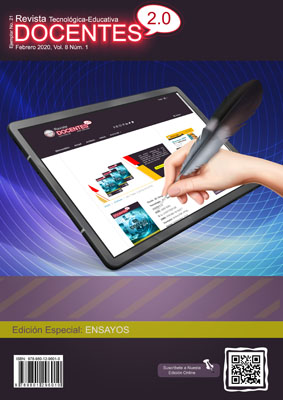The Spiral of Technology in Education ... Will you Reach its Zenith?
 DOI:
https://doi.org/10.37843/rted.v8i1.79
DOI:
https://doi.org/10.37843/rted.v8i1.79
Main Article Content
Abstract
The present work identifies various educational moments that, as categorical determinations, have been subsumed and give meaning to the concrete notion ...
Downloads
Metrics
Article Details

This work is licensed under a Creative Commons Attribution-NonCommercial-NoDerivatives 4.0 International License.
Those authors who have publications in our journal accept the following terms:
- When a work is accepted for publication, the author retains rights of reproduction, distribution of his/her article for exploitation in all countries of the world in the format provided by our magazine and any other magnetic medium, optical, and digital.
- Authors will retain their copyright and guarantee the journal the right first to publish their work, which will be simultaneously subject to the Creative Commons Acknowledgment License (Attribution-NonCommercial-NoDerivatives 4.0 International (CC BY-NC-ND 4.0)). That allows third parties to copy and redistribute the material in any medium or format, under the following conditions: Acknowledgment - You must properly acknowledge authorship, provide a link to the license, and indicate if any changes have been made. You may do so in any reasonable way, but not in a way that suggests you have the licensor's endorsement or receive it for your use. NonCommercial - You may not use the material for a commercial purpose. NoDerivatives - If you remix, transform, or build from the material, you cannot broadcast the modified material. There are no additional restrictions - You cannot apply legal terms or technological measures that legally restrict you from doing what the license allows.
- Authors may adopt other non-exclusive license agreements to distribute the published version of the work (e.g., deposit it in an institutional archive or publish it in a monographic volume) provided that the initial publication in this journal is indicated.
- Authors are allowed and recommended to disseminate their work through the Internet (e.g., in institutional telematic archives, repositories, libraries, or their website), producing exciting exchanges and increasing the published work's citations.
- Request of withdrawal an article has to be done in writing by the author to the Editor, becoming effective after a written response from the Editor. For this purpose, the author or authors will send correspondence via e-mail: [email protected].
- The author will not receive financial compensation for the publication of his work.
- All Docentes 2.0 Journal publications are under the Open Journal System (OJS) platform at: https://ojs.docentes20.com/.
References
Cechinel, C., Rebollo, R. y Sánchez-Alonso, S. (2011). Objetos de aprendizaje: definición y caracterización. En F.J. Álvarez y J. Muñoz (coords.). Avances en objetos de aprendizaje(pp.21-46). Editorial DGDV.
Garza, B. (2012). Modelo didáctico para el aprendizaje de objetos de aprendizaje. En E. Ruiz-Velasco (coord.), Tecnologías de la Información y la comunicación para la innovación educativa(pp. 287-322). Editorial Días de Santos.
Heredia, Y. (2010). Innovación educativa a través del uso estratégico de las tecnologías de información y comunicación. En J.V. Burgos y A. Lozano (coords.). Tecnología educativa y redes de aprendizaje de colaboración: retos y realidades de innovación en el ambiente educativo(pp.19-35). Editorial Trillas.
López, M. (2017). Aprendizaje, competencias y TIC(2nd ed.). Editorial Pearson.
Siemens. G. (2011). Conectivismo: una teoría de aprendizaje para la era digital. En Aparici. R. (coord.). Conectados en el ciberespacio(pp.77-90). Editorial UNED.
Siemens. G. (2010). Conociendo el conocimiento. Editorial Nodos Ele.
Zabalza, A. y Zabalza, M. (2012). Innovación y cambio en las instituciones educativas.Editorial Homo Sapiens.






